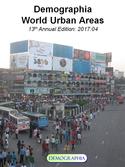The Pearl River (Zhujiang) Delta has developed into the world’s ultimate city (Figure 1). More people live in the urbanization there than in any space of similar size in the world (Figure 2). Once home to separate urban enclaves comprising 9 million residents in 1980, the now adjacent urban areas of the Pearl River Delta are home to 55 million residents, nearly one-half more in either the Yangtze Delta adjacent urban areas (which have undergone a similar development process) or the Tokyo-Yokohama urban area with 38 million residents (Note 1). read more »
Asia
Ultimate City: Guangdong-Hong Kong-Macao Greater Bay Area (with Photographic Tour)
- Login to post comments
The Value of All Things Crazily Rich and Asian
Neither Kevin Kwan’s novel “Crazy Rich Asians” nor the movie based on it should win any prizes as literature or film. Yet the “Crazy” phenomena — both the best-selling book, its sequels and the smash movie — represent a critical moment not only in Asian, and Asian-American, history, but in how we look at race. read more »
- Login to post comments
‘Chinafornia’ And Global Trade In Age Of Trump
One of the last regions settled en masse by Europeans, California’s trajectory long has been linked to its partners across the Pacific. Yet these ties could be deeply impacted by President Trump’s immigration and trade policies, as well as resulting blowback by the authoritarian regime in Beijing. read more »
- Login to post comments
Urumqi: World’s Remotest Large City (The Evolving Urban Form)
Urumqi (alternate spelling “Wulumuqi”) is the most remote large city in the world from a seacoast. Urumqi is approximately 1,500 miles (2,400 kilometers) from the Bay of Bengal, in the Indian Ocean, just south of Dhaka, Bangladesh (Image 1). It is farther from Beijing, China’s national capital than to India’s national capital, Delhi. read more »
- Login to post comments
Still Set to Depopulate, Japan Raises Long Term Population Projection
Japan is well known for its huge expected population loss, likely to be the greatest in the world for a major nation by the end of the century. However, things do not look as bleak as they did just five years ago. read more »
- Login to post comments
The 37 Megacities and Largest Cities: Demographia World Urban Areas: 2017
Many of the world’s biggest cities are getting bigger still. In 2017, the number of megacities --- urban areas with better than ten million people --- increased to 37 in 2017, as the Chennai urban area entered their ranks. Chennai becomes India’s fourth megacity, along with Delhi, Mumbai and Kolkota. These are among the major findings in the just released 13th annual edition of Demographia World Urban Areas, which provides population, land area and population density estimates for the 1,040 identified built-up urban areas (cities) in the world. read more »
- Login to post comments
The End of the Asian Era
For the past 40 years, the Pacific Rim has been, if you will, California’s trump card. But now, in the age of President Donald Trump and decelerating globalization, the Asian ascendency may be changing in ways that could be beneficial to our state. read more »
- Login to post comments
Death Spiral Demographics: The Countries Shrinking The Fastest
For most of recent history, the world has worried about the curse of overpopulation. But in many countries, the problem may soon be too few people, and of those, too many old ones. In 1995 only one country, Italy, had more people over 65 than under 15; today there are 30 and by 2020 that number will hit 35. Demographers estimate that global population growth will end this century. read more »
- Login to post comments
How Post-Familialism Will Shape the New Asia
Surprisingly, the modern focal point for postfamilial urbanism comes from eastern Asia, where family traditionally exercised a powerful, even dominant influence over society. The shift toward post-familialism arose first in Japan, the region’s most economically and technologically advanced country. As early as the 1990s sociologist Muriel Jolivet unearthed a trend of growing hostility toward motherhood in her book Japan: The Childless Society? –a trend that stemmed in part from male reluctance to take responsibility for raising children. read more »
- Login to post comments
Shanghai to Manchuria and Central China by Train
There is no better way to see China than by train. This is especially true because foreigners are not allowed to drive rental cars without first obtaining a Chinese drivers license. China has developed the world's largest high-speed rail system, which includes one of only three profitable routes in the world, along with Tokyo to Osaka and Paris to Lyon. read more »
- Login to post comments




















